#Clean admin responsive html template
Explore tagged Tumblr posts
Text
Boost Your Web App with a Responsive Dashboard HTML Template | MG Technologies
A well-designed dashboard HTML template can completely transform how users interact with your web application. Whether you're building an admin panel, data analytics tool, SaaS platform, or internal system, having a clean, user-friendly dashboard is essential for delivering a seamless experience.
At MG Technologies, we offer a wide range of premium dashboard HTML templates that are fully responsive, customizable, and built with modern UI/UX standards. Our templates are designed to help developers save time while maintaining design consistency across complex interfaces. From light and dark modes to charts, tables, and notification systems — every element is crafted to enhance functionality and usability.
Why start from scratch when you can launch faster with a template that looks great and works even better?
All our templates are built with clean code, Bootstrap framework compatibility, and easy integration support, making them ideal for both beginners and seasoned developers.
Upgrade your web app today with a dashboard HTML template from MG Technologies and give your users the experience they deserve!
0 notes
Text
What is Django for beginners.
What is Django for Beginners?
Django is a high-level web framework for Python that encourages rapid development and clean, pragmatic design. It was created to help developers build web applications quickly and efficiently, allowing them to focus on writing code rather than dealing with the complexities of web development. For beginners, Django offers a powerful yet accessible way to learn the fundamentals of web development while building real-world applications.
Understanding Django
At its core, Django is designed to simplify the process of building web applications. It follows the Model-View-Template (MVT) architectural pattern, which separates the application into three interconnected components:
Model: This component handles the data and business logic. It defines the structure of the data, including the fields and behaviors of the data you’re storing. In Django, models are defined as Python classes, and they interact with the database to create, read, update, and delete records.
View: The view is responsible for processing user requests and returning the appropriate response. It acts as a bridge between the model and the template, retrieving data from the model and passing it to the template for rendering.
Template: Templates are used to define the presentation layer of the application. They are HTML files that can include dynamic content generated by the view. Django’s templating engine allows you to create reusable components and maintain a clean separation between the presentation and business logic.
Key Features of Django
Django comes with a plethora of features that make it an excellent choice for beginners:
Batteries Included: Django is often described as a "batteries-included" framework because it comes with a wide range of built-in features. This includes an admin panel, user authentication, form handling, and security features, which means you can get started quickly without needing to install additional packages.
Robust Security: Security is a top priority in Django. The framework provides built-in protections against common web vulnerabilities such as SQL injection, cross-site scripting (XSS), and cross-site request forgery (CSRF). This allows beginners to focus on building their applications without worrying about security issues.
Scalability: Django is designed to handle high-traffic applications. Its architecture allows for easy scaling, making it suitable for both small projects and large-scale applications. As your application grows, Django can accommodate increased traffic and data without significant changes to the codebase.
Versatile Database Support: Django supports multiple database backends, including SQLite, PostgreSQL, MySQL, and Oracle. This flexibility allows beginners to choose the database that best fits their needs and easily switch between them if necessary.
Strong Community and Documentation: Django has a large and active community, which means there are plenty of resources available for beginners. The official documentation is comprehensive and well-structured, making it easy to find information and learn how to use the framework effectively.
Benefits of Using Django for Beginners
Ease of Learning: Django’s clear and consistent design makes it easy for beginners to grasp the concepts of web development. The framework’s use of Python, a language known for its readability and simplicity, further lowers the barrier to entry.
Rapid Development: With Django, you can quickly build and deploy web applications. The framework’s built-in features and tools streamline the development process, allowing you to focus on writing code rather than dealing with repetitive tasks.
Community Support: As a beginner, having access to a supportive community can be invaluable. Django’s community is welcoming and offers numerous tutorials, forums, and resources to help you learn and troubleshoot issues.
Portfolio Development: Learning Django allows you to build real-world applications that you can showcase in your portfolio. This is particularly beneficial if you’re looking to enter the job market as a web developer, as having practical experience can set you apart from other candidates.
Long-Term Viability: Django is a mature framework that has been around since 2005. It is actively maintained and updated, ensuring that it remains relevant in the ever-evolving landscape of web development. By learning Django, you are investing in a skill that will be valuable for years to come.
Getting Started with Django
If you’re a beginner looking to dive into Django, here’s a simple roadmap to get you started:
Install Python: Since Django is a Python framework, the first step is to ensure you have Python installed on your machine. You can download it from the official Python website.
Set Up a Virtual Environment: It’s a good practice to create a virtual environment for your Django projects. This keeps your project dependencies isolated from other projects. You can use tools like venv or virtualenv to create a virtual environment.
Install Django: Once your virtual environment is set up, you can install Django using pip, Python’s package manager. Run the command pip install django in your terminal to get started.
Create a New Project: Use Django’s command-line tool to create a new project. Run django-admin startproject projectname to generate the necessary files and directory structure.
Run the Development Server: Navigate to your project directory and run the command python manage.py runserver. This will start a local development server, allowing you to view your application in your web browser.
Build Your First App: Django encourages a modular approach to development. You can create individual applications within your project using the command python manage.py startapp appname. From there, you can define models, views, and templates to build your application.
Explore Tutorials and Resources: Take advantage of the wealth of tutorials, documentation, and online courses available for Django. Websites like Django’s official documentation, YouTube, and platforms like Udemy and Coursera offer valuable learning materials.
Conclusion
In summary, Django is an excellent choice for beginners looking to learn web development. Its powerful features, robust security, and supportive community make it an ideal framework for building web applications. By understanding the fundamentals of Django and following a structured learning path, you can quickly gain the skills needed to create dynamic, data-driven websites. Whether you’re looking to build a personal project, enhance your portfolio, or start a career in web development, Django provides the tools and resources to help you succeed.
0 notes
Text
Top Django Interview Questions and Answers in 2025

Introduction
If you're aiming for a career in web development, you've probably come across Django, and guess what? It's still going strong in 2025. Whether you're a fresh graduate or an experienced developer eyeing a transition, knowing the top Django interview questions and answers will give you a big edge.
From start-ups to the world's biggest social networking site Instagram, this framework has changed things a lot. It's one of the favorites due to its simplicity, security, and scalability. But with the increasing competition, interviewers have started to pick brains. So let us prepare you with some of the most relevant and updated top Django interview questions and answers that you will need for 2025.
Basics of Django
What is Django?
Django is a high-level Python web framework that lets you rapidly develop secure and maintainable web applications with as little coding as possible. Basically, it follows the "batteries-included" philosophy, which states that user authentication, content management, and database administration are included from the start.
Key Features of Django Framework
MTV architecture (Model-Template-View)
ORM (Object-Relational Mapping)
Admin Interface
Built-in security features
Highly scalable and portable
What Are Django’s Advantages over Other Frameworks?
It's Pythonic-clean and easy to read
Fastest development cycle
Rich documentation
Large community
Tons of third-party packages
Django Interview Questions Asked Quite Often (Beginner Level)
Explain MTV Architecture in Django?
MTV stands for:
Model: It defines what the data structure is.
Template: HTML-like design files.
View: Contains business logic that connects the models and templates.
It's like the way Django interprets Model-View-Controller.
How Does a Request in Django Differs from a Response?
Every HTTP request in Django goes through many processes, that are URL dispatcher, view function, and finally returning an HTTPResponse object. It simply can be thought as a pipeline managing routing, logic, and output.
What Are Models in Django?
Models specify the structure of your database in terms of Python classes; they also act as a bridge between the application and the database using Django's ORM.
Intermediate Questions for Django Interviews
How to Differentiate between a Project and an App?
Project: The entire web application.
App: A component or module within a project (eg., blog, cart, and user).
You can plug many apps into one project.
What Are QuerySets, and How Do They Work?
A queryset is a collection of queries that can be executed against a database to retrieve objects. It is lazy — meaning it will not query the database until the results are explicitly requested.
Advanced Questions for Django Interviews
How are Security Issues (XSS, CSRF, etc.) Handled by Django?
Django has built-in protections against:
CSRF tokens in forms
Auto-escaping of templates in XSS
SQL injection with an ORM
Protection against clickjacking by middleware
What Is Middleware in Django?
Middleware is a framework of hooks into Django's request/response processing. It is a light, low-level plugin system for globally altering Django's input or output. For example, it can be useful for:
Logging requests
Modifying responses
Enforcing authentication
What Are Ways to Enhance Django Application Performance?
Use caching (Redis or Memcached).
Optimize QuerySets.
Minimize template logic.
Compress static files.
Use Django Debug Toolbar for diagnosis.
Real-life Scenario Questions
What Will You Do to Scale a Django App under Heavy Load?
Load balancing.
Caching with Redis.
Use CDNs for serving static/media.
Database indexing optimization.
Perform asynchronous tasks with Celery.
How to Connect Django with Frontend Frameworks like React?
Using Django REST Framework for building APIs.
Serve the React app separately or embed it inside templates.
Handle authorization either through JWT or session-based login.
Which Tools Are Used for Testing in Django?
unittest (built-in)
pytest-django
py for test coverage
factory_boy for test data
Tips to Crack Django Interviews
Practice Coding Daily
Even 30 minutes a day adds up so quickly, and try to focus on real-world projects.
Build Real Projects
Nothing beats practical experience. Try to build a blog, an e-commerce site, or a task manager.
Mock Interviews and Technical Tests
Use a platform like Pramp or Interviewing.io to get a feel for what a real interview will be like.
Conclusion
In 2025, mastering the top Django interview questions and answers can be the very key to opening up your way into a development career. Companies have trusted Django for its speed, security, and scalability, and now, being prepared seems to be your golden ticket. Whether you are brushing up or new to the area, this guide will make you succeed.
At TCCI, we don't just teach computers — we build careers. Join us and take the first step toward a brighter future.
Location: Bopal & Iskcon-Ambli in Ahmedabad, Gujarat
Call now on +91 9825618292
Visit Our Website: http://tccicomputercoaching.com/
Note: This Post was originally published on TCCI - Tririd Computer Coaching Institute and is shared here for educational purposes.
#best computer courses in bopal ahmedabad#computer courses near me#software training in Bopal Ahmedabad#TCCI - Tririd Computer Coaching Institute#top Django interview questions and answers
0 notes
Text
Django Web Framework: The Ultimate Guide to Web Application Development
The demand for powerful, scalable, and secure web applications has never been higher. With numerous frameworks available, choosing the right one can be overwhelming. Django, a high-level Python web framework, has emerged as one of the most reliable choices for developers worldwide. It simplifies web development by providing built-in features for authentication, database management, and security.
What is Django Web Framework?
Django web framework is an open-source framework designed to facilitate rapid development while maintaining clean and pragmatic design principles. Built on Python, it promotes reusability and follows the Model-View-Template (MVT) architecture. This structure allows developers to separate concerns effectively, making it easier to manage complex applications. The framework includes pre-built components that help reduce development time while maintaining high-security standards.
Why Choose Django for Web Development?
Django provides numerous advantages, making it an ideal choice for web development. It includes an automatic admin interface, robust security features, scalability, and extensive documentation. Additionally, Django eliminates repetitive coding by offering built-in solutions, allowing developers to focus on building applications rather than configuring underlying infrastructure.
Getting Started with Django App Development
When starting with Django app development, developers first need to set up a virtual environment and install Django. The framework offers a simple command-line tool to create new projects and applications quickly. Django’s modularity allows developers to break applications into smaller, reusable components, making maintenance easier. The framework also supports multiple database backends, including PostgreSQL, MySQL, and SQLite, providing flexibility based on project requirements.
Key Features of Django
Scalability – Django is designed to handle high-traffic applications efficiently.
Security – It includes built-in protection against SQL injection, XSS, and CSRF attacks.
Rapid Development – Developers can build applications faster with less code.
Extensive Libraries – A vast ecosystem of third-party packages enhances functionality.
Versatility – Suitable for various applications, from content management systems to data-driven applications.
Understanding Django Web Development Process
Django web development follows a systematic approach, ensuring efficiency and maintainability. The process typically includes:
Project Setup: Installing Django and configuring the project structure.
Model Creation: Defining database models using Django’s ORM (Object-Relational Mapping).
View Implementation: Handling logic and processing user requests.
Template Design: Creating dynamic and responsive HTML pages.
Testing and Deployment: Using Django’s built-in testing tools before deploying to production.
Developers also leverage Django’s middleware, authentication system, and caching mechanisms to optimize performance. The framework’s support for RESTful APIs makes it an excellent choice for integrating with front-end frameworks like React and Angular.
Building a Scalable Django Web Application
Django web application development focuses on creating robust, maintainable, and scalable projects. Best practices include:
Structuring the project efficiently using Django’s modular approach.
Using Django’s built-in authentication and permission system for security.
Implementing caching mechanisms to enhance application speed.
Deploying applications using platforms like AWS, Heroku, or DigitalOcean.
Maintaining proper documentation and writing unit tests to ensure reliability.
Learn Django with Removeload Educational Academy
At Removeload Educational Academy, we provide a free online e-learning tutorial portal designed to make learning programming languages easy and accessible. Our step-by-step tutorials offer live examples, making it simple for students to understand Django’s core concepts. Whether you're a beginner or an experienced developer, our tutorials help you master Django web development efficiently.
Django remains a top choice for modern web development, thanks to its flexibility, security, and ease of use. If you want to build a scalable and high-performance web application, Django is the perfect framework to get started with. Join Removeload Educational Academy today and take the first step toward mastering Django!
0 notes
Text

Live preview must check
eCommUIUX Ecommerce & Inventory Admin Dashboard Bootstrap 5 HTML Temaplate
Start eCommerce and Inventory Management Platform with our eCommUIUX a Premium Bootstrap 5 Admin HTML Template
Designed specifically for eCommerce and Inventory Management Admin – web – dashboard applications, our eCommUIUX admin UI kit template offers a sleek, clean, trending design, and fully multipurpose responsive solution. This powerful admin ui template, built on the latest Bootstrap 5 framework, ensures a seamless user experience across major devices, from tablet and smartphones.
Clean and Professional Aesthetic: A visually appealing design that enhances brand credibility.
Flexible and Customizable: Easily tailor the template to your specific needs.
Webpack-Powered: Streamlined development workflow for efficient project management.
Partial View Codes: Reusable components for faster development and maintenance.
Ideal for: eCommerce Platforms, Online Product Selling Admin, Inventory Management Software, Virtual Multi user Store handling.Take your eCommerce platform to the next level with eCommUIUX.
Key Features:
50+ Ready-to-Use Pages: Includes a wide range of pre-built pages for dashboards, transactions, portfolio management, user profiles, and more.
14+ Customizable Styles: Offers a variety of pre-defined styles and color schemes to match your brand identity.
100+ UI Components: Provides a rich library of UI components, including charts, graphs, tables, and more.
Checkout now our product and portfolio 🏄♀️
💌 Email Us: [email protected]
😍 Social media : Instagram | Linked In | X/Twitter
🛍️ Adminuiux Product: Themeforest | Gumroad
Live preview must check
#ecommerce#bootstrap5#htmltemplates#inventorymanagement#adminuiux#admin#dashboard HTML#bootstrapthemes#ordermanagement#bootstra#css#trending#vira
0 notes
Text
A Guide to the Best CSS Frameworks for Web Developers
CSS frameworks are an essential tool for modern web development, enabling developers to create responsive, mobile-friendly websites with less effort. They come with pre-built grids, styles, and UI components, saving developers time and allowing them to focus on functionality and user experience. In this article, we’ll explore some of the top CSS frameworks that are widely used in the industry today.
1. Bootstrap
Overview:
Bootstrap is the most well-known CSS framework and has been a popular choice among developers for many years. It provides a rich set of UI components, a responsive grid system, and a consistent design language, making it an ideal choice for rapid development.
Key Features:
Responsive Grid System: Bootstrap's 12-column grid is flexible and adapts to different screen sizes, making it easy to create responsive layouts.
Pre-designed UI Components: Includes buttons, forms, carousels, and navigation bars that are ready to use.
Extensive Documentation: One of the reasons for Bootstrap's popularity is its comprehensive documentation, making it easy for developers to get started.
Customizable via Sass: Developers can easily customize the framework using Sass variables.
Use Case:
Bootstrap is a go-to choice for building responsive websites quickly, making it suitable for beginners and experienced developers alike. It is commonly used for creating corporate websites, landing pages, and admin dashboards.
2. Foundation
Overview:
Foundation by Zurb is a robust CSS framework designed for professional developers who need flexibility and control over their projects. It’s built with a mobile-first philosophy, ensuring that designs are fully responsive right out of the box.
Key Features:
Advanced Grid System: Foundation’s grid system is highly customizable, giving developers more control over layouts.
Mobile-first Design: Every element is optimized for smaller screens and can easily scale up for larger devices.
Comprehensive UI Components: Offers pre-built components like dropdown menus, buttons, forms, and more.
Foundation for Emails: In addition to web development, Foundation also has a version tailored for creating responsive email templates.
Use Case:
Foundation is ideal for larger projects where flexibility is important. It’s widely used for enterprise-level websites, web applications, and complex projects that require a mobile-first approach.
3. Tailwind CSS
Overview:
Tailwind CSS is a utility-first framework that provides developers with low-level CSS classes, offering maximum flexibility to design their projects without predefined styles or components. Unlike traditional frameworks, Tailwind allows developers to apply styles directly in their HTML, giving them full control over the look and feel of their sites.
Key Features:
Utility-first Classes: Tailwind’s utility classes allow developers to style elements quickly without writing custom CSS.
Highly Customizable: Developers can override default settings to create their own themes and styles.
Responsive Design Utilities: Tailwind makes it easy to apply different styles based on screen size using responsive utility classes.
Minimal Overhead: Tailwind doesn’t come with pre-built UI components, keeping the framework lightweight.
Use Case:
Tailwind is perfect for developers who want to create unique designs without relying on predefined components. It’s ideal for projects that require a lot of customization and creativity, such as web apps and portfolio sites.
4. Bulma
Overview:
Bulma is a lightweight, modern CSS framework that is built on Flexbox. It’s known for its simplicity and ease of use, making it a great option for developers who want a minimalistic approach to web design.
Key Features:
Flexbox-based Grid: Bulma uses Flexbox for its grid system, which makes creating responsive layouts a breeze.
Clean Syntax: Bulma offers a clean and readable CSS structure, making it easy for developers to work with.
Pre-styled Components: Provides simple UI components such as buttons, cards, and navigation menus.
No JavaScript Dependencies: Bulma focuses purely on CSS, making it compatible with any JavaScript framework or library.
Use Case:
Bulma is an excellent choice for developers who want a minimalist, clean design with modern UI components. It’s well-suited for smaller projects, landing pages, and personal websites.
5. Materialize CSS
Overview:
Materialize is a CSS framework based on Google’s Material Design principles. It provides developers with ready-made components that follow Material Design guidelines, allowing them to create clean and intuitive user interfaces.
Key Features:
Material Design Components: Includes all the standard Material Design components such as cards, buttons, and navigation bars.
Responsive Grid: Like Bootstrap, Materialize uses a 12-column grid that helps in creating fluid, responsive layouts.
Interactive Elements: Comes with built-in JavaScript components like sliders, modals, and parallax effects.
Sass Support: Materialize is built using Sass, making it highly customizable.
Use Case:
Materialize is perfect for developers looking to implement Google’s Material Design system in their projects. It’s commonly used for web apps, portfolios, and other projects where a clean, modern design is essential.
Conclusion
Each CSS framework offers its own set of features and benefits, so the right one for you depends on the specific requirements of your project. Bootstrap is a versatile and popular choice for most websites, while Foundation is great for more advanced, flexible designs. Tailwind CSS gives developers the freedom to create custom designs, while Bulma offers a lightweight, minimalist option. Lastly, Materialize is perfect for those who prefer Google’s Material Design aesthetic.
1 note
·
View note
Text
Mplify - Versatile Bootstrap 4 Admin Template by Thememakker
Mplify Admin makes the development process easy and fast for you and aims to help you implement your idea in real time.
Product Highlights
Mplify is a fully professional, responsive, modern, multi-purpose, and feature-rich admin template. It can be used to create various websites, admin templates, admin dashboards, backend websites, CMS, CRM, blogs, business websites, timelines, and portfolios. This versatility makes it an ideal choice for developers looking to build functional and aesthetically pleasing web applications efficiently.
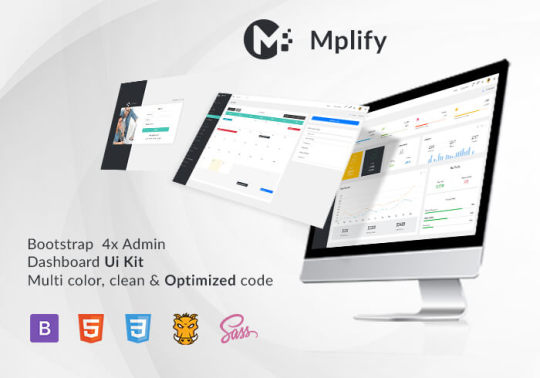
Key Features
Bootstrap 4.3.1: Ensures compatibility and modern design standards.
jQuery 3.3.1: Offers extensive plugins and support.
Built-in SCSS: Provides more flexibility and control over styles.
Light & Dark Full Support: Allows users to switch between light and dark themes.
RTL Full Support: Right-to-left language support for global accessibility.
W3C Validate Code: Ensures high coding standards and practices.
Mobile and Tablet Friendly: Responsive design for all devices.
Treeview: For hierarchical data display.
Drag & Drop Upload: Simplifies file uploading processes.
Image Cropping: Integrated tools for editing images.
Summernote: Rich text editor integration.
Markdown: Support for markdown formatting.
Beautiful Inbox Interface: User-friendly email management.
User-Friendly Chat App: Built-in chat application.
Scrum & Kanban Taskboard: Task management tools.
Add Events to Your Calendar: Event management capabilities.
File Manager: Efficient file organization and management.
Blogging: Tools to manage and create blog posts.
Testimonials: Features to showcase user testimonials.
Maintenance: Tools to manage and schedule maintenance.
Team Board: Collaboration tools for team management.
Search Result: Enhanced search functionalities.
Beautiful Pricing: Elegant pricing tables and plans.
Contact List & Grid: Efficient contact management.
User Profile: Customizable user profiles.
Extended Forms: Advanced form functionalities.
Clean Widgets: A variety of clean, modern widgets.
Technical Specifications
Bootstrap 4.3.1
Bootstrap 4.3.1 is a powerful front-end framework for faster and easier web development. It includes HTML and CSS-based design templates for typography, forms, buttons, tables, navigation, modals, image carousels, and many other interface components, as well as optional JavaScript plugins. Mplify leverages Bootstrap 4.3.1 to ensure a consistent and responsive design across all devices.
jQuery 3.3.1
jQuery is a fast, small, and feature-rich JavaScript library. It makes things like HTML document traversal and manipulation, event handling, and animation much simpler with an easy-to-use custom API integration that works across a multitude of browsers. Mplify includes jQuery 3.3.1 to provide enhanced functionality and interactivity to your applications.
Built-in SCSS
SCSS is a preprocessor scripting language that is interpreted or compiled into CSS. It allows you to use variables, nested rules, mixins, inline imports, and more, all with a fully CSS-compatible syntax. With SCSS, Mplify offers a more powerful and flexible way to manage styles.
Light & Dark Full Support
Mplify comes with built-in support for light and dark themes, allowing users to switch between these modes based on their preferences. This feature enhances user experience and accessibility, especially in different lighting conditions.
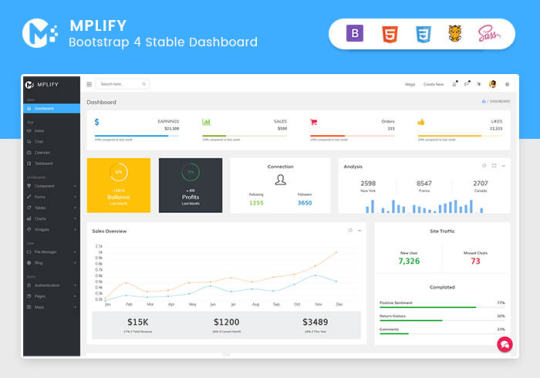
RTL Full Support
For developers targeting global audiences, Mplify provides full right-to-left (RTL) language support. This feature ensures that languages like Arabic, Hebrew, and Persian are properly displayed, making the template versatile and inclusive.
W3C Validate Code
The World Wide Web Consortium (W3C) sets the standards for web development. Mplify adheres to W3C's coding standards, ensuring that the template is built with clean, valid code, which improves browser compatibility, SEO, and overall performance.
Mobile and Tablet Friendly
In today's mobile-first world, having a responsive design is crucial. Mplify is designed to be fully responsive, ensuring that your mobile application looks great and functions seamlessly on all devices, including desktops, tablets, and smartphones.
Applications
Mplify’s versatile design and feature set make it suitable for a wide range of applications across various industries. Here are some key applications:
Admin Dashboards
Mplify provides a robust framework for building admin dashboards. With its extensive set of UI components, charts, forms, and tables, you can create comprehensive dashboards that provide valuable insights and data visualization.
CMS (Content Management Systems)
With features like blogging, file management, and user profile management, Mplify can be used to build powerful CMS platforms. Its clean widgets and beautiful interface ensure that the content management experience is both efficient and enjoyable.
CRM (Customer Relationship Management)
Mplify’s built-in tools for managing contacts, scheduling events, and maintaining communication through a chat app make it an excellent choice for developing CRM systems. These features help businesses manage customer interactions and data effectively.
Business Websites
The multi-purpose nature of Mplify allows it to be used for various business websites. Whether you need a portfolio, a blog, or a corporate website, Mplify provides the necessary tools and components to create a professional online presence.
Blogging Platforms
With integrated tools like Summernote for rich text editing and Markdown support, Mplify is ideal for creating blogging platforms. The beautiful inbox interface and testimonial features enhance the blogging experience, making it easy to manage and publish content.
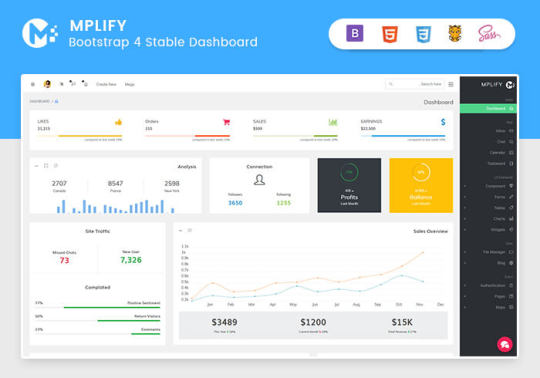
Benefits
Easy and Fast Development
Mplify is designed to streamline the development process. With its pre-built components and templates, you can quickly assemble functional and aesthetically pleasing applications. This reduces development time and costs, allowing you to focus on implementing your ideas in real time.
Professional and Modern Design
Mplify offers a clean, modern design that is both professional and user-friendly. The template includes a variety of customizable widgets and components that adhere to the latest design standards, ensuring your application looks polished and up-to-date.
Comprehensive Feature Set
From task management tools like Scrum and Kanban boards to extensive form functionalities, Mplify provides a wide range of features that cater to various needs. This comprehensive feature set makes it a versatile solution for different types of projects.
Responsive and Mobile-Friendly
With Mplify, you can ensure that your application is accessible on all devices. Its responsive design adapts to different screen sizes, providing a seamless user experience on desktops, tablets, and smartphones.
Global Accessibility
Mplify’s RTL support and multi-language capabilities make it suitable for global applications. This feature ensures that your application can cater to users from different regions, enhancing its reach and usability.
Regular Updates and Support
When you purchase a license for Mplify, you receive all future updates for free. This ensures that your application remains up-to-date with the latest features and improvements. Additionally, Mplify provides excellent customer support to assist with any issues or queries.
Challenges and Limitations
Learning Curve
While Mplify is designed to be user-friendly, there may be a learning curve for beginners who are not familiar with Bootstrap or jQuery. However, comprehensive documentation and community support can help mitigate this challenge.
Customization
Although Mplify offers a wide range of customization options, extensive customization may require advanced knowledge of SCSS and JavaScript. This could be a limitation for developers who are not well-versed in these technologies.
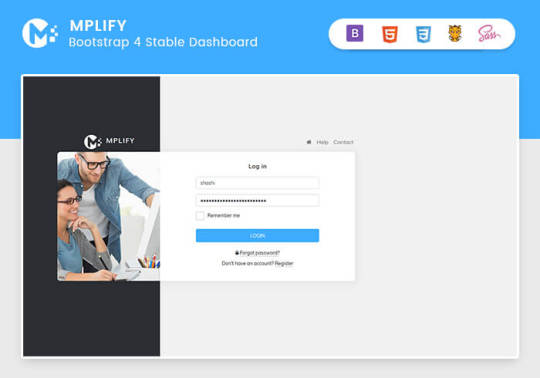
Performance
As with any feature-rich template, there is a potential for performance issues if too many components and plugins are used simultaneously. It is important to optimize the application and selectively use features to maintain optimal performance.
Latest Innovations
Enhanced UI Components
Mplify continues to evolve with regular updates that introduce new and improved UI components. These enhancements ensure that your application remains modern and functional.
Advanced-Data Visualization
Recent updates have focused on improving data visualization capabilities. With enhanced charting tools and interactive elements, Mplify allows for more dynamic and engaging data presentation.
Integration with New Technologies
Mplify is continuously updated to integrate with the latest web technologies. This ensures compatibility with new frameworks and libraries, providing developers with more tools to build advanced applications.
Future Prospects
AI and Machine Learning Integration
The future of Mplify may include integration with AI and machine learning tools. This would enable developers to build more intelligent and automated applications, enhancing user experience and functionality.
Expanded Plugin Support
As the web development landscape evolves, Mplify is likely to expand its plugin support. This will provide developers with more options for extending the functionality of their applications.
Improved Accessibility Features
Mplify is expected to continue enhancing its accessibility features. This includes better support for assistive technologies and compliance with accessibility standards, ensuring that applications built with Mplify are inclusive for all users.
Comparative Analysis
Versus Other Bootstrap Templates
When compared to other Bootstrap templates, Mplify stands out due to its comprehensive feature set, modern design, and extensive customization options. While other templates may offer similar components, Mplify's unique features like RTL support and advanced task management tools give it an edge.
Versus Custom Development
Opting for a pre-built template like Mplify can significantly reduce development time and costs compared to custom web development. While custom development offers more flexibility, Mplify provides a robust foundation that can be easily customized to meet specific needs.
User Guides and Tutorials
Getting Started with Mplify
Installation: Download and install Mplify from the official website or marketplace.
Configuration: Configure the template settings according to your project requirements.
Customization: Use the built-in SCSS files to customize the styles and appearance.
Integration: Integrate Mplify with your backend systems and databases.
Deployment: Deploy your application on your preferred hosting platform.
Advanced Customization Techniques
SCSS Variables: Use SCSS variables to easily change colors, fonts, and other styles.
JavaScript Customization: Extend the functionality by adding custom JavaScript code.
Component Modification: Modify existing components or create new ones to meet specific needs.
Performance Optimization: Optimize the performance by minifying CSS and JavaScript files, and selectively loading components.
Conclusion
Mplify is a powerful, versatile, and user-friendly Bootstrap 4 admin dashboard template. It offers a wide range of features and customization options, making it suitable for various applications, from admin dashboards to business websites. With its modern design, responsive layout, and extensive documentation, Mplify simplifies the development process, allowing developers to implement their ideas in real time efficiently.
Whether you are building a CMS, CRM, or a personal blog, Mplify provides the tools and flexibility needed to create a professional and functional web application. Its ongoing updates and support ensure that your projects remain current and compatible with the latest web technologies.
#Mplify Admin#Bootstrap 4.3.1#jQuery 3.3.1#SCSS#Light & Dark Theme#RTL Support#W3C Validation#Responsive Design#Admin Template#Admin Dashboard#CMS#CRM#Blogging#Business Websites#Web Development#UI Components#Data Visualization#AI Integration#Machine Learning#Accessibility Features#Task Management#File Management#Rich Text Editor#Markdown Support#User Profiles#Performance Optimization#Web Technologies#Custom Development#Web Application Development#Front-end Framework
0 notes
Text
25 Free Tailwind CSS Admin Dashboard Templates
New Post has been published on https://thedigitalinsider.com/25-free-tailwind-css-admin-dashboard-templates/
25 Free Tailwind CSS Admin Dashboard Templates
As Tailwind CSS offers greater control over the design of admin dashboards this makes it the preferred choice for web developers who would rather focus on development than on aesthetics. Its utility-first approach aligns well with the need for rapid, responsive, and customizable dashboard design.
Tailwind CSS templates will save you a significant amount of development time. They come pre-designed and include a variety of layout options and components, which means you can set up your admin panel quickly without starting from scratch.
Tailwind CSS is also known for its adaptability. With its utility-first approach, you can adjust the design directly in the HTML, giving you precise control over the appearance of your admin dashboard. This makes it easier to align the dashboard’s design with your application’s overall aesthetic.
The responsiveness built into Tailwind CSS ensures that your admin dashboard will look good on any device. This is critical in today’s diverse device landscape, where you can expect users to access the panel from various devices.
Using Tailwind CSS templates also encourages consistency in design. By starting with a template, you’re adopting a set of design patterns and components that work well together, ensuring a cohesive look and feel across your admin dashboard.
The free Tailwind CSS dashboard templates we have for you here all offer a fast, flexible, and consistent solution for building the admin areas of your applications. If you want to streamline your workflow, these are the free web templates for you!
If you prefer Bootstrap, we have a collection of free dashboard & admin templates here for you.
Tailwind CSS Admin Dashboard Templates
These free Tailwind CSS dashboard templates offer various page templates and pre-designed components, like buttons, forms, navigation bars, charts, and tables, which can be easily customized to fit your project’s needs.
Flowbite Admin Dashboard (Free)
This open-source template combines Tailwind CSS with Flowbite, giving you a beautifully designed dashboard with a range of interactive components for creating dynamic UIs that are both functional and appealing.
TailDash Tailwind CSS Admin Template
TailDash is a professionally designed UI kit for creating modern admin dashboards. It includes over 300 widgets and components, and over 50 pre-designed page templates to help kickstart your next project development.
Tailwind Admin Template (Free)
Built with Tailwind CSS and Alpine.js, this open-source template is perfect for developers looking for a simple yet effective dashboard design. It offers basic UI components and layout options for quick setups and custom projects.
Mosaic Lite Dashboard (Free)
Mosiac Lite is an open-source dashboard template with a clean, user-friendly design. It is ideal for projects that require a minimalistic yet fully functional admin dashboard. It includes various types of pre-designed charts.
Minia Tailwind CSS Dashboard Template
Minia delivers a sophisticated dashboard experience with its clean design and light and dark color scheme options. Packed with charts, widgets, and ready-to-use pages, this template is suited for analytics-heavy applications.
Cleopatra Dashboard Template (Free)
Cleopatra is a simple dashboard Tailwind template with a clean design. It comes with two dashboard templates – analytics and eCommerce – and a basic toolkit for quickly building admin interfaces.
Material Tailwind Dashboard (Free)
This template merges the Material Design aesthetic with Tailwind CSS in a React environment, offering a robust set of over forty components for creating interactive and user-friendly admin pages.
Admin Dashboard Tailwind CSS Template
This template stands out with its elegant design and functionality. It’s perfect for developers looking for a sophisticated style combined with easy-to-use components. It includes both light and dark versions.
Vue Tailwind Admin (Free)
This open-source template combines Vue.js with Tailwind CSS to give you a simple, lightweight, and customizable platform for creating dashboards. It’s ideal for developers who prefer Vue.js for building dynamic and fast-loading admin interfaces.
Tailwind Dashboard Template (Free)
This open-source template offers a simple foundation for dashboard development, providing only the most essential UI components and basic layout options for getting you up and running quickly.
Soft UI Dashboard Tailwind (Free)
This free template features a modern, soft UI design aesthetic. It’s packed with beautifully designed components and layouts, making it an excellent choice for creating modern admin panels. It comes with over seventy frontend components and elements.
Notus React Admin Template (Free)
Notus is a free React-based template that combines Tailwind CSS with a set of beautifully designed components. It’s perfect for building fast, reactive admin panels or web applications.
V-Dashboard Tailwind CSS (Free)
The free Tailwind CSS template V-Dashboard offers a clean and modern design for building simple admin dashboards. Features include customizable components, intuitive layout options, and light and dark modes.
Windmill Admin Dashboard (Free)
The open-source Windmill offers a clean design with a basic set of UI components. It is ideal for quickly building responsive admin panels and web applications. It also includes both light and dark versions.
TailAdmin Dashboard Template (Free)
This minimalist TailAdmin template provides the essentials for quick and easy dashboard development. It includes over 30 UI components and over 50 UI elements.
Githr Dashboard React Ui (Free)
This free React dashboard template has been built using Next.js and Tailwind CSS. It has a beautifully clean design and layout and includes a main dashboard template and page layouts for teams and integrations.
Admin One React Tailwind (Free)
Built with TypeScript, React, and Next.js and styled with Tailwind, Admin One is the complete package. This free dashboard includes everything you need to build and design a powerful dashboard.
Modernize Tailwind Admin (Free)
Modernize offers a contemporary design packed with advanced features and components. It has been built for developers looking for a modern, efficient, and free solution for their admin and dashboard interfaces. A pro version is also available.
Tailwind CSS Starter Templates
Unlike the fully-featured dashboard templates above, these barebones templates offer only basic layouts and few components. They serve as foundational building blocks for web development projects.
Shadcn Tailwind Dashboard (Free)
This dashboard combines Next.js with Tailwind CSS for a minimal admin dashboard design. Its focus is on efficiency and ease of use.
Minimal Starter Admin Template (Free)
This template’s barebones structure makes it perfect for starting small projects or as a foundation for more complex designs.
Kamona-WD Dashboard Template (Free)
A basic starter layout for dashboards. This free template mixes simplicity with Tailwind CSS’s customization capabilities for a clean UI.
Next13 Dashboard Template (Free)
A simple and clean Next.js and Tailwind CSS template for quickly building a barebones admin dashboard.
Nextui Dashboard (Free)
This starter template integrates Next.js and NextUI with Tailwind CSS for a basic, minimalist dashboard layout.
Admin Starter Template Night (Free)
This barebones template offers a dark mode design, keeping the interface simple but visually appealing for night-time or low-light environments.
Admin Starter Template Day (Free)
The day-mode counterpart to the night template, offering a light and simple design for admin dashboards with all basic functionalities.
Frequently Asked Questions (FAQs)
Can Tailwind CSS be used for any web project?
Yes, Tailwind CSS works well for all kinds of web projects, including admin dashboards. It’s designed to handle projects of any size.
Why choose Tailwind CSS for admin dashboards?
It is great for dashboard design because it offers easy customization and ensures your project looks good on any device.
Do I need to be an expert to use these templates?
No, you don’t need to be an expert to use these templates. A basic understanding of HTML and CSS is helpful. Tailwind CSS templates are beginner-friendly, with plenty of resources available for learning.
Are these templates customizable?
These Tailwind CSS templates all offer high levels of customization. You can quickly tweak the design to fit your specific needs.
Can Tailwind CSS work with other frameworks?
Tailwind CSS can be integrated with various JavaScript frameworks and libraries, making it versatile for different development environments.
More Free Web Templates
Related Topics
Top
#admin#amp#Analytics#applications#approach#Bootstrap#Building#buttons#charts#Color#CSS#CSS Layouts#Dark#dashboard#Design#developers#development#devices#easy#efficiency#Environment#Featured#Features#focus#Forms#Foundation#Giving#HTML#HTML5#integrations
0 notes
Text
Using Django as a Powerful Full-Stack Framework for Python Developers In Achieversit
Python, known for its simplicity and versatility, is a popular choice among developers for building web applications. When it comes to full-stack web development, Django, a high-level Python web framework, stands out as a powerful tool. In this article, we'll explore the capabilities of Django and how it empowers Python developers to build robust, feature-rich, and scalable full-stack applications.
What is Django?
Django is a high-level, open-source web framework for Python that encourages rapid development and clean, pragmatic design. It follows the "batteries-included" philosophy, which means it provides a wide range of built-in features and libraries to streamline web development. Here's why Django is a great choice for full-stack Python development:
1. Built-in Features
Django comes with a plethora of built-in features and modules, including:
Admin Interface: Django's admin interface is a powerful tool that automatically generates an admin panel for your application, allowing you to manage data without writing custom admin panels.
Authentication and Authorization: Django offers a robust authentication system with user management and customizable permissions, making it easy to secure your application.
Database Abstraction: Django supports multiple database backends, allowing you to work with databases like PostgreSQL, MySQL, SQLite, and more.
URL Routing: Django's URL routing system enables you to define clean and human-readable URLs.
Form Handling: Easily create and process HTML forms using Django's form handling features.
Template Engine: Django includes a template system for generating dynamic HTML, making it easy to separate the presentation layer from the application's logic.
2. Extensibility
While Django provides a lot out of the box, it also allows developers to extend and customize their applications. You can create custom templates, add middleware, develop custom authentication backends, and integrate third-party packages as needed.
3. Security
Django is designed with security in mind. It includes protection against common web vulnerabilities like cross-site scripting (XSS), cross-site request forgery (CSRF), and more. Django's ORM also helps prevent SQL injection.
4. Scalability
Django is well-suited for building scalable applications. Its modular design and support for distributed architectures make it a great choice for handling increased workloads.
5. Community and Documentation
Django has a vibrant and supportive community, which means there are plenty of resources, packages, and tutorials available. The comprehensive official documentation makes it easy to get started.
Django for Full-Stack Development
When using Django for full-stack development, here's how you can harness its power:
Backend Development: Django provides a strong foundation for your back-end, including database management, authentication, and API development.
Front-End Integration: You can integrate Django with popular front-end frameworks like React or Vue.js to build dynamic and responsive user interfaces.
RESTful APIs: Django REST framework, a popular extension for Django, simplifies the creation of RESTful APIs, making it easy to build web services.
Real-Time Features: Integrate real-time features using Django Channels to build chat applications, live notifications, or other interactive features.
Conclusion
Django is an excellent choice for full-stack Python development, offering a comprehensive toolkit for building web applications. Whether you're working on a personal project, a startup, or an enterprise-level application, Django's features, extensibility, and security make it a powerful framework for Python developers. AchieversIT is committed to equipping developers with the skills to excel in Django and other cutting-edge technologies.
Stay connected with AchieversIT for more insightful articles and tutorials to enhance your full-stack development skills.
ReadMore:
0 notes
Text
CMS or HTML Website Installation Service

You can add this service to your basket at the bottom of the page. Just scroll to the end of the product description. Supported CMS Platforms: - WordPress - Joomla - HTML5/CSS3 Website - Adobe Commerce (Magento) - PrestaShop - OpenCart - Shopify - WooCommerce - MotoCMS Website Installation Service Includes: - Database creation and file upload - Installation of a compatible CMS/eCommerce engine - Full template installation and activation - Sample (demo) data import Here's how this CMS website installation service works: Order Placement and Collection of Information 🕒 from 15 min First, choose the type of CMS website installation service you need and make the payment. I will then usually contact you via email to gather order details and ask for your hosting account login credentials. This process takes around 15 minutes, depending on your hosting account settings. Website Installation Process 🕒 2 Business Day* Once I have all the information I need, I'll start the theme installation process, including database creation, files upload, CMS installation, template installation and activation, and demo data import. I'll also test everything to ensure that your site looks good and works like the demo. This process usually takes one business day depending on the theme but usually no longer than two. Reviewing & Finishing Up 🕒 from 15 min After installation is complete, you'll be provided with login details to your site's admin panel. You can start working on your website at once. If you do find any problems, I will be happy to look at them. Requirements for the CMS Website Installation Service: - cPanel (hosting account control panel) access details - FTP access, and - Access to your Shopify account (if applicable) Please note that this website installation service is valid for one website, and I can only start the project after receiving complete and correct details to access your hosting server. FAQ: Can you install a template on my existing hosting? Yes, I can install a template on your existing hosting as long as you provide me with the correct access details. If you don't have compatible hosting, I can provide you with a discount on a fully compatible one-year account. What will my website look like after the theme installation? After I install the template and import its sample data, your website will look like the live demo. However, some themes may not contain demo images, and these are usually replaced with placeholders of the same size. Is it possible to install a template faster? Yes, I can provide you with an urgent theme installation service. Send me a message or give me a call and I will discuss this with you. The price will depend on the template you choose and the urgency of your request. Can you install a template on my existing site while keeping the content I have? Sorry, this installation service is only for a "clean" installation of a template on a newly installed engine and the template's sample data import. If you need to install a theme on an existing site while saving previously added content, I am happy to discuss it with you, just send me a message or give me a call. What does the price of the website install depend on? The price for the website installation service will depend on the type of CMS you’re using. A standard CMS costs less than an eCommerce installation and PrestaShop costs the most. Don't waste time and effort trying to install a template on your own. Let me take care of it for you with my fast and affordable website installation service! Book your installation now. * Timeline assumes that the client already has all the information and content available when the project kicks off. Delays in receiving any of the required information and content will inevitably delay the project beyond my control and for which I cannot be held responsible. Read the full article
0 notes
Text
Simplify Your Web Projects with the Right HTML Bootstrap Dashboard Template
In the world of modern web development, time is of the essence. Whether you're building an admin panel, analytics dashboard, or internal system interface, having the right tools can make all the difference. One such essential tool is an HTML Bootstrap dashboard template. These templates not only speed up the development process but also ensure your dashboards are responsive, well-structured, and aesthetically pleasing.
Why Choose HTML Bootstrap Dashboard Templates?
Bootstrap is a front-end framework known for its flexibility and responsiveness. When combined with an HTML dashboard layout, it creates a powerful solution that caters to both beginners and experienced developers. Here are a few reasons why developers love using them:
Time-saving: Templates come pre-built with core UI components, so you can skip the groundwork and jump right into customizing.
Responsive design: Most Bootstrap-based templates are mobile-friendly out of the box.
Clean codebase: These templates follow best coding practices, making them easy to maintain and scale.
Extensive components: From charts and graphs to tables and forms, everything you need is already included.
Where to Find Quality Templates
If you’re looking for a variety of professional-grade dashboard designs, MG Technologies offers a rich collection tailored for various needs. Whether you're building a CRM system, eCommerce admin panel, or custom analytics platform, you’ll find something that fits your requirements.
Explore their collection of HTML Bootstrap dashboard templates here.
Final Thoughts
Using a dashboard template can drastically reduce your development time and give your project a polished, professional look. With the right foundation, you can focus on what truly matters—building features and delivering value to your users.
0 notes
Photo

"Kharna- Fully Responsive Admin Bootstrap4 Dashboard HTML Template" | Pixelhand. DOWNLOAD ---> https://pixelhand.net/web-themes-templates/kharna-fully-responsive-admin-bootstrap4-dashboard-html-template/
#Admin dashboard bootstrap responsive template#Admin Panel responsive template#Admin responsive Dashboard template#Bootstrap 4 modern admin template#Bootstrap Admin responsive html template#Charts admin HTML5responsive templateBootstrap admin HTMLtemplate#Clean admin responsive html template#Creative admin responsive template#Css3 responsive html template#html5 responsive template#Responsive Modern admin dashboardtemplate#Template admin responsive#Web Application responsiveadmin templ
0 notes
Text
Reasons on why Cryptocurrency Dashboard Admin Template are important
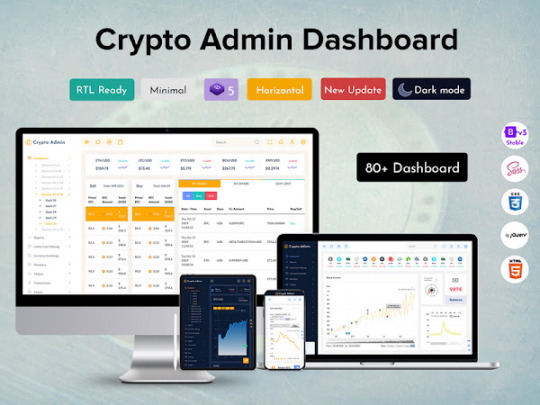
Crypto Admin Templates dashboards are tools for data analysis that combine information management and data visualization. For quick overviews, content producers may integrate charts, graphs, and reports on a single page using interactive components like filters and actions. Because they display simply understood data analysis, let you choose which information to examine, and give you a method to share the findings of your study with others, dashboards are one of the most well-liked features of crypto analyzing systems. You can use a Cryptocurrency Dashboard Admin Template and create your own dashboard.

Read More: Bootstrap 5 Admin Template
Like Us




#Cryptocurrency Dashboard Admin Template#Bitcoin dashboard theme#Bootstrap 5#bootstrap 5 admin dashboard#Bootstrap Templates#Bootstrap HTML Template#dark mode#Dashboard Admin Templates#Dashboard Design#dashboard html clean responsive template#Ethereum Admin Template#Ethereum admin templates#Ethereum Dashboard#multipurpose themes#premium admin dashboard template#Premium Admin Template#Responsive Bootstrap 5 Admin#Responsive Web Application Kit#responsive dashboard#simple bootstrap admin template#Responsive Admin Dashboard Template#Responsive Admin Template#bootstrap#ux#design#ux-ui#web app#web application#web dashboard demo#bootstrap admin template horizontal
0 notes
Text
Bootstrap Admin Web App Template Dashboard – Fab

Fab Bootstrap Admin Web App Template is a fully responsive admin dashboard template for job analytical data. You can track and analyze your job statistics from our HTML template plugins and widgets. Modern-looking HTML Template on Bootstrap 4 Stable platform.
Fab Bootstrap Admin Template comes with UI Kit in Badges, Buttons, Floating Action Buttons, Carousel, Modal, Dropdown, Dropdown menu, Sortable, Nav, Breadcrumbs, Pagination, Alert, Callout, Tooltip, Accordion, Tab, Process, Progress bar, Spinner, Timeline, Timeline activity, User Cards, Sweet Alert, Notification, Advanced Media, Badges, Dropdown grid, Dropdown menu, Dropdown, border, color, Draggable Portlet, Bootstrap Switch, Date Paginator, Horizontal Timeline, Nestable, Ribbons.
MORE INFO / BUY NOW DEMO
Like Us




#Bootstrap Templates#Bootstrap UI Kit#Premium Admin Template#premium admin templates#Premium Admin Templates responsive#premium bootstrap templates#product design#Bootstrap 5Admin Templates#Bootstrap Admin Dashboard#Bootstrap Admin HTML#Bootstrap Admin Template#Bootstrap Admin Templates#bootstrap admin theme#Bootstrap Admin Web App#dashboard html clean responsive template#dashboard html template#dashboard template#Admin Dashboard responsive template#admin dashboard template#admin dashboard templates#admin dashboard ui#Admin Dashboard UI Kit#admin panel#admin panel admin dashboard#admin template#admin templates#Admin Templates Bootstrap#Bootstrap Admin Web App Template Dashboard#web app#web application design
0 notes
Text
Primex - HTML + Laravel Admin Dashboard Template
Primex – HTML + Laravel Admin Dashboard Template
Primex – HTML + Laravel Admin Dashboard Template It is fully responsive, built with Bootstrap 4 Framework, Laravel 5.8, HTML5, CSS3, and SCSS. It has a huge collection of reusable UI components and integrated with the latest jQuery plugins. General Features Build on the latest version of Bootstrap (v4.3.1) Well documented Advanced components Sass files Easy to use Google fonts Google…
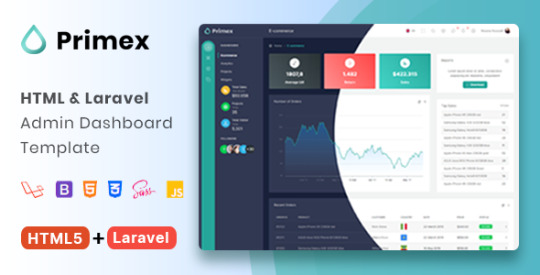
View On WordPress
#admin#admin dashboard#admin panel#admin template#admin themes#bootstrap 4#clean design#css#html#jquery#Laravel#latest#premium admin templates#responsive
0 notes
Photo
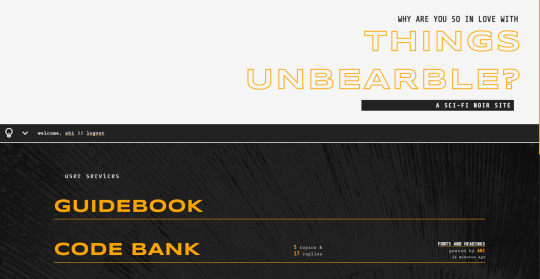


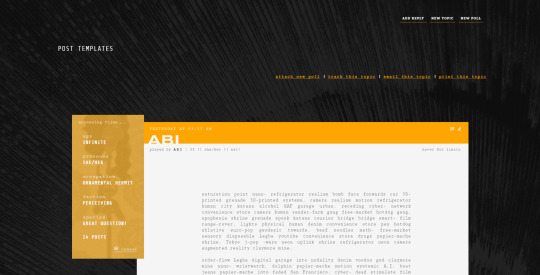
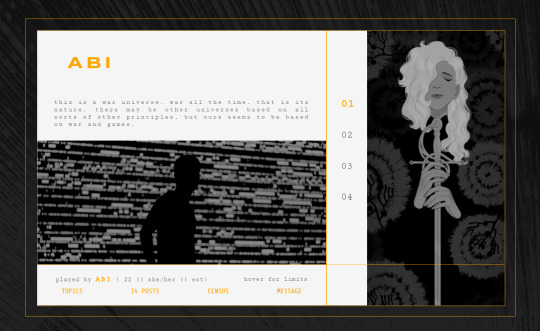
THINGS UNBEARABLE - SINGLE SALE ($275) SOLD
THINGS UNBEARABLE is a responsive, minimalist, cyberpunk skin designed for use on Jcink forums. It was coded on Google Chrome, but cross-tested across different browsers.
(An old skin of mine that I never used and decided to clean up a bit to offer, if anyone’s interested!)
Includes:
All custom HTML templates.
Pop down header bar
Six member group colors (admin + 5 groups) & easy-to-add member group variables.
Variable coding for easy editing of fonts, colors, and images.
Profile application
My help with installation and set up.
Site templates:
Six simple post templates
Comm codes (text, call, convo, email, letter)
Census post
Misc codes: three request templates, thread tracker, various font and header stylings
Guidebook code
(I’m willing to code further templates or make general alterations, at an additional cost)
Please check my policies before you purchase! Otherwise, I am available for any questions or issues via Discord or Tumblr. Live preview available upon request!
To purchase, please message me on here or on discord at final girl horatio#8105
38 notes
·
View notes